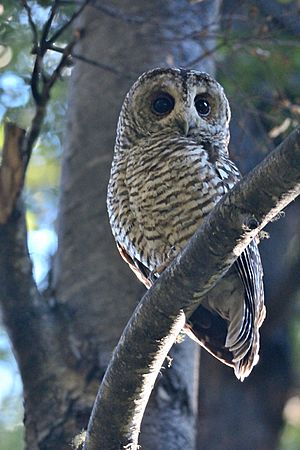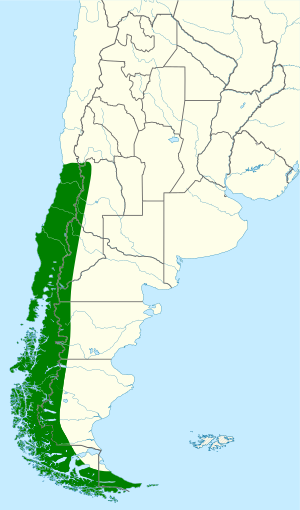Rufous-legged owl facts for kids
Quick facts for kids Rufous-legged owl |
|
|---|---|
 |
|
| Adult, Ñuble forest, Chile | |
| Conservation status | |
| Scientific classification | |
| Genus: |
Strix
|
| Species: |
rufipes
|
 |
|
The rufous-legged owl (scientific name: Strix rufipes) is a medium-sized owl that lives in parts of Argentina and Chile. This owl is known for its unique appearance and its quiet life in the forests of South America.
Contents
Understanding the Rufous-Legged Owl's Family
The rufous-legged owl has two main types, called subspecies. These are Strix rufipes rufipes and S. r. sanborni. The sanborni type is only known from one young owl ever found. Another owl, the Chaco owl (Strix chacoensis), was once thought to be a subspecies of the rufous-legged owl. However, scientists later found that they are different. They look different, have different body shapes, and even make different sounds.
What Does a Rufous-Legged Owl Look Like?
The rufous-legged owl has a compact body and a round head. It does not have the ear tufts that some other owls have. These owls are about 33 to 38 cm (13 to 15 in) long. They weigh around 350 g (12 oz). Female owls are usually bigger than the males.
Adult rufous-legged owls have a reddish-brown face. They have white "eyebrows" above their dark brown eyes. The feathers around their beak are also white. Their upper body is dark reddish-brown with thin orange-buff stripes and spots. Their tail is also reddish-brown with buff stripes.
The owl's throat is white. Most of its belly is a creamy white with many black stripes. The area near its legs is orange-buff. Its legs and toes are covered with soft, buff-colored feathers. Young chicks are covered in fluffy off-white down. Older young owls are warm buff-colored with faint brown stripes and a reddish-brown face.
Where Do Rufous-Legged Owls Live?
You can find the rufous-legged owl in Chile, starting from the Valparaíso Province. In western Argentina, they live from the Mendoza Province all the way south to the tip of Tierra del Fuego. The only known S. r. sanborni owl was found on Chiloé Island in south-central Chile.
These owls mostly live in moist, old-growth forests. These forests have a thick tree canopy and lots of plants growing underneath. They can also be found in older secondary forests (forests that have grown back after being cut down) and forests that are partly open. They live from sea level up to at least 2,000 m (6,600 ft) high in the mountains.
How Rufous-Legged Owls Behave
Hunting for Food
The rufous-legged owl is a nocturnal animal, meaning it is active at night. It usually hunts for food from a perch, like a tree branch. Its main food source is small mammals that live in trees. They also eat birds, amphibians, and insects, but these make up only a small part of their diet.
Reproduction and Life Cycle
Scientists do not know much about how rufous-legged owls reproduce. They likely start laying eggs in October. A female owl usually lays one to three eggs at a time. These owls often nest in holes in trees. These holes can be natural or made by woodpeckers. Sometimes, they might use an old nest built by another bird of prey. It is also thought that they might sometimes nest on the ground.
Owl Sounds and Calls
The rufous-legged owl makes many different sounds. These include "grunting, hooting, and cackling noises."
Conservation Status of the Rufous-Legged Owl
The IUCN (International Union for Conservation of Nature) has listed the rufous-legged owl as a species of "Least Concern." This means that its population is currently stable and not in immediate danger. However, even though it lives in some protected areas, its habitat is at risk. Logging, which is cutting down trees, can threaten the mature forests where these owls live.
See also
 In Spanish: Strix rufipes para niños
In Spanish: Strix rufipes para niños



